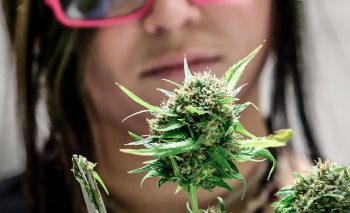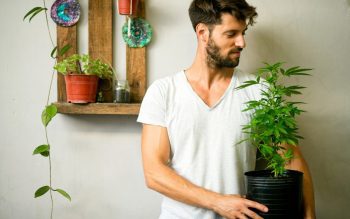By Marco Torres
Guest writer for Wake Up World
There are many medicinal herbs that grow well indoors and cannabis is one of them. Besides the many medicinal wonders of cannabis itself, the benefits of growing your own plants are many:
1) Get the highest quality strains
Most people are unaware that there are different strains of cannabis and many are energizing rather than mellowing. Growing your own plants allows you to experiment with strains that may benefit your lifestyle and dietary strategies more than others. Also, I can almost guarantee that along with unwelcome chemicals, there are many different pesticides that may be tagging along with even reputable medical sources. Growing your own gives you the control on quality and allows you to grow organically.
2) Save money
You can literally save thousands of dollars by growing your own. No amount of seeds, soil, water, pots, electricity, and any other equipment needed will ever add up to the amount of money wasted on buying cannabis from others.
[pro_ad_display_adzone id=”110028″]
3) Educate yourself on indoor gardening
Think about everything you’ll need to know to grow your own cannabis plants. Your indoor growing area will need reflective walls, proper lighting, ventilation and you will need to be prepared to prevent disease from spreading to your plants. You’ll also need the right indoor seeds. Plus there are great strains of cannabis that can be found cheap and you will find them. By the time you get your indoor garden going, you’ll have plenty of knowledge and you can then help others on their own journey.
10 Steps to Growing Your Own Cannabis Plants
The following assumes that you will be growing 6-30 plants at any time. You can grow fewer but, if the law permits, you might as well optimize the lighting and space for the electricity you are using as the yield will never go to waste regardless.
The basic elements of the environment (light, water, air, and soil) provide plants with their fundamental needs. These environmental factors affect the growth rates of plants, as well as their life cycles. If one factor is deficient, growth rate and vigour will wan regardless of the other three. For instance, with low light, the growth will be limited no matter how fertile and moist the soil is. In the same sense, if soil minerals are scarce, the growth rate will be limited no matter how you increase the light.
A pot size of 6″x6″x6″ should be perfect to support good growth for each plant.
1) Secure Your Growing Premises
Please ensure that before you initiate such a project that you have secured your home sufficiently to prevent thieves from entering. Given the high price of illegal cannabis, theft is always a serious concern when growing any type of indoor or outdoor garden. Some common measures include steel reinforced doors, an alarm system, motion lighting, property fences, dogs, and of course human supervision.
Regardless if you are cultivator for medicinal purposes or recreational, never advertise your plants to anybody you don’t wholeheartedly trust with a key to your home. Home burglaries are a common occurrence and 99% of time, the burglars only want one thing — your cannabis plants which are quite valuable on the street markets.
2) Don’t Forget Safety
You’re going to be working with electricity and water, so make sure the two don’t mix! Be organised: keep wires off the floor using neat cable tacks. Label the plugs. Use good quality timers with the correct amps for the light system being used. No matter whether growing in soil or hydroponics, make sure any excess water drains safely. In fact if your indoor grow room is above ground floor it’s a good idea to “carpet” the entire area with builder’s plastic up to just above skirting board level in case you have leaks.
3) Manage Odour
Some cannabis strains have strong odours when they grow. Different strains such as white widow will smell more than others. As soon as the plant moves into the flowering phase, the concentration of odours will increase. This usually takes anywhere from 1-4 months depending on the strain.
Selectively breed cannabis for minimal odours. With the aid of experience and knowledge, you can clone breeds that have different or a more subtle smell, which is less pungent that others. Though this can be hard, and can only really be achieved if you experiment with many strains, and cross-breeding. But you may stumble upon a strain with less pungency but the same in any other way.
Avoid attempting to cover up the smell with any type of deodorant, spray, car freshener or plug-in device as all of these add an element of toxicity to the room and depending on how much is used can actually kill your plants.
One method of air filtration is to use carbon filtering with fans when withdrawing odour from the room. These filters are useful, but do run out of ability as time goes on, so you probably want to replace it when you feel the filter has expired or no longer effective. If necessary, you may need to consider installing venting systems: a system of pipes/vents that draw out the smell from a small room.
Keeping cannabis plants well ventilated and cold is one of the easiest ways to prevent the smell from escaping. Not too cold though — they won’t like anything below 65F/18C.
4) Optimize Ventilation
Your plants need good ventilation to breathe, so you have to consider how to make your extractor work most efficiently. Making the grow room as air tight as possible helps this. The airflow intake should be on a low level at one side, the air out take on the opposite side up high (because heat rises). If you can avoid your air intake coming from outside as cold air will shock young plants.
Each fan has a rating that tells you how many cubic feet of air per minute (CFM) it will move. When dealing with above average temperatures you will want your fan to exchange the grow room air 3-5 times in one minute, so for a room that is 40 cubic feet, a fan that is capable of moving 120-200 cfm (cubic feet per minute) is recommended. If you only want to replace depleted levels of co2 and are growing in a closed area using fluorescents, one room change per five minutes (divide room size by 5) will be adequate.
To calculate your room size, multiply Width by Length by Height, this will give you the CFM rating required for one room change per minute.
For internal circulation oscillating fans are probably the most efficient devices for circulating air in a room. The gentle back and forth sway of the fan is very beneficial for the developing plants. These fans tend to keep anaerobic molds down by constantly freshening any potentially stagnant air. Home improvement centres carry a large array of various types and styles of air-moving fans, there are wall-mounted styles available and most are relatively inexpensive.
5) Create The Right Environment
Temperature needs to be controlled using either heating (possibly with the case of LEDs) or more likely heat extraction. Humidity should also be monitored and a rH gauge is useful for this. During seedling stage humidity needs to be high (which is why many gardeners use a propagator) but even in vegetative growth, a relative humidity of 65- 80% will increase the growth rate.
6) Lighting Is Key
You must have consistent lighting for cannabis plants since they are photoperiod and must have relative lengths of both light and dark periods. They will be effected by changes in the light cycle.
The photoperiod necessary for flowering will vary slight with: (1) the variety, (2) the age of the plant, (3) its sex, and (4) growing conditions.
Under artificial light the photoperiod is, of course, any length you wish. The most popular way to grow with artificial lights is the harvest system. Start the plants under long light periods of from 16 to 18 hours daily. After the plants have reached a good size, usually between three and six months, shorten the light cycle to about 12 hours to force flowering.
As long as the day-length is long, the plants continue vegetative growth. If female flowers do appear, there will only be a few. These flowers will not form the characteristic large clusters or buds. If the days are too short, the plants flowers too soon, and remain small and underdeveloped.
Cannabis varieties originating from more northerly climes (short growing seasons) react to as little as nine hours of night. Most of these are hemp and seed varieties that are acclimated to short growing seasons, such as the weedy hemp’s of Minnesota or southern Canada. Varieties from more southerly latitudes need longer nights with 11 to 13 hours of darkness. Since most cannabis plants are acclimated to southerly latitudes, they need the longer nights to flower. To be on the safe side, if you give Cannabis plant dark periods of 13 or more hours, each night for two weeks, this should be enough to trigger flowering.
The older a plant (the more physiologically developed), the quicker it responds to long nights. Plants five or six months old sometimes form visible flowers after only four long nights. Young cannabis plants (a month or so of age) can take up to four weeks to respond to long nights of 16 hours.
Both male and female Cannabis are long-night plants. Both will flower when given about two weeks of long nights. The male plant, however, will often flower fully under very long days (18 hours) and short nights (six hours). Males often flowers at about the same time they would if they were growing in their original environment.
The inside area needs to reflect light. You’re paying for this light in size of light you buy and the electricity it uses so you need to maximise the light efficiency. Reflected light can increase the amount of light the plants receive by around a third. Artificial light will reduce with distance, so it is important to contain and direct the light within an appropriately sized area.
Some parts of the fluorescent light spectrum are more efficient than others. Deluxe warm white and deluxe cool white are all conducive to good growth and should be widely available. All types of growing light should have a reflector box around them directing the light towards the plants. The walls should also be painted white to reflect the light. You should get the longest light that will fit into your space and a relatively high wattage.
7) Choose The Right Seeds
One of the most important steps in starting a cannabis garden is choosing a cannabis seed to plant. There are numerous kinds of cannabis seeds that you can buy in the market today, and choosing which one to use can be quite the task in itself. Cannabis seeds vary in so many aspects, and you might want to know how they differ so that you can decide which one is most suited for you.
There are different kinds of cannabis strains. You have probably heard that they are divided into four distinct categories that have dozens of other strains belonging to each of them. These four categories are the cannabis indica strain, cannabis sativa strain, cannabis ruderalis strain, and cannabis hybrid strains. Each of them is characterized by different attributes, and it might take a while for you to decide which one to settle for. Some grow better indoors, while some need more sunlight to produce flowers. Some produce flowers of certain colors, while others have shorter leaves and thicker stalks.
CBD (Cannabidiol), one of the main constituents of the cannabis plant has been proven medically to relieve many diseases including the inhibition of cancer cell growth. Recently, research has shown CBD to have analgesic, anti-inflammatory and anti-anxiety properties without the psychoactive effects (the “high” or “stoned” feeling) that THC provides. While high THC strains often tout levels of over 20%, generally, CBD levels of over 4% are considered to be high.
Strains vary from grower to grower, crop to crop and even plant to plant, so keep in mind that the actual medication’s CBD levels may vary. However, there are some strains that have been actively bred in recent years to have higher CBD levels, so they might be a good place to start. They include Charlotte’s Web, Harlequin, Sour Tsunami and Cannatonic.
Because cannabis seeds are different from each other, they also produce yield that are different. There are cannabis seeds that produce much more yield than the others. If you care about yield, then select a cannabis seed that can produce the amount of yield you desire within a specific period.
[pro_ad_display_adzone id=”110030″]
8) Soil Is Critical
Your prime concern, after choosing high quality seeds, is the soil. Use the best soil you can get. Scrimping on the soil doesn’t pay off in the long run. If you use unsterilized soil you will almost certainly find parasites in it, probably after it is too late to transplant your cannabis. You can find excellent soil for sale at your local plant shop or nursery, K-Mart, Wal Mart, and even some grocery stores. The soil you use should have these properties for the best possible results:
- It should drain well. That is, it should have some sand in it and also some sponge rock or pearlite.
- The pH should be between 6.5 and 7.5 since cannabis does not do well in acidic soil. High acidity in soil encourages the plant to be predominantly male, an undesirable trait.
- The soil should also contain humus for retaining moisture and nutrients.
Most of us are supplied water by the city and some cities add more chemicals to the water than others. They all add chlorine, however, in varying quantities. Humans over the years have learned to either get rid of it somehow or to live with it, but your cannabis plants won’t have time to acquire a taste for it so you had better see that they don’t have to. Chlorine will evaporate if you let the water stand for 24 hours in an open container. Letting the water stand for a day or two will serve a dual purpose: The water will come to room temperature during that period of time and you can avoid the nasty shock your plants suffer when you drench them with cold water. Always water with room temperature to lukewarm water. If your water has an excessive amount of chlorine in it, you may want to get some anti- chlorine drops at the local fish or pet store. The most important thing about watering is to do it thoroughly. You can water a plant in a three gallon container with as much as three quarts of water. The idea is to get the soil evenly moist all the way to the bottom of the cannabis. If you use a little water, even if you do it often, it seeps just a short way down into the soil and any roots below the moist soil will start to turn upwards toward the water.
9) Sterilized Containers
After you have prepared your soil, you will have to come up with some kind of container to plant in. The container should be sterilized as well, especially if they have been used previously for growing other plants.
The size of the container has a great deal to do with the rate of growth and overall size of the plant. You should plan on transplanting your plant not more than one time, since the process of transplanting can be a shock to the plant and it will have to undergo a recovery period in which growth is slowed or even stopped for a short while. The first container you use should be no larger than six inches in diameter and can be made of clay or plastic. To transplant, simply prepare the larger cannabis by filling it with soil and scooping out a little hole about the size of the smaller cannabis that the plant is in. Turn the plant upside down, cannabis and all, and tap the rim of the cannabis sharply on a counter or the edge of the sink. The soil and root ball should come out of the cannabis cleanly with the soil retaining the shape of the cannabis and with no disturbances to the root ball.
10) Fertilizer Is Food
Cannabis plants like lots of food, but you can do damage to the plants if you are too zealous. Some fertilizers can burn a plant and damage its roots if used in too high a concentration. Most commercial soil will have enough nutrients in it to sustain the plant for about three weeks of growth so you don’t need to worry about feeding your plant until the end of the third week. The most important thing to remember is to introduce the fertilizer concentration to the plant gradually. Start with a fairly diluted fertilizer solution and gradually increase the dosage. Eco-Grow is especially good for cannabis since it contains a naturally derived nutrients that keeps the soil from becoming acid. Most fertilizers cause a pH change in the soil. Adding fertilizer to the soil almost always results in a more acidic pH.
Remember to increase the amount of food your plant receives gradually. Cannabis seems to be able to take as much fertilizer as you want to give it as long as it is introduced over a period of time. During the first three months or so, fertilize your plants every few days. As the rate of foliage growth slows down in the plant’s preparation for blooming and seed production, the fertilizer intake of the plant should be slowed down as well. Never fertilize the plant just before you are going to harvest it since the fertilizer will encourage foliage production and slow down resin production. A word here about the most organic of fertilizers: worm castings. As you may know, worms are raised commercially for sale to gardeners. The breeders put the worms in organic compost mixtures and while the worms are reproducing they eat the organic matter and expel some of the best cannabis food around. After the worms have eaten all the organic matter in the compost, they are removed and sold and the remains are then sold as worm castings. These castings are so rich that you can grow cannabis in straight worm castings. This isn’t really necessary however, and it is somewhat impractical since the castings are very expensive. If you can afford them you can, however, blend them in with your soil and they will make a very good organic fertilizer.
Using Natural Light
Sometimes people grow plants in their windows for more than a year without any female flowers ever forming. This is because household lamps are turned on sometime at night, illuminating the plants. Under natural light exclusively, indoor plants flower at about the same time they would outdoors (sometimes a bit sooner because it is warmer indoors or the plants may be shaded).
When plants are well developed and you want them to flower, make sure that no household lamps or nearby street lamps are shining on them. During late fall and winter, the natural day-length is short enough for the plants to flower naturally, if you simply keep off any lights at night that are in the same room as the plants. If you must use light, use the lowest wattage possible, such as a six-watt bulb. (The hormone is also least sensitive to blue light.) Shield the light away from the plants. Or shield the plants from any household light with aluminum foil curtains.
Once the flowers are forming clusters, you can discontinue the dark treatments, especially if it is more convenient. However, if it is too soon (when you see only a few random flowers), household lights can reverse the process.
By using natural light, you can grow indoor crops all year. The winter light is weak and the days are short, so it is best to use artificial lights to supplement daylight, as well as to extend the photoperiod. The extra light will increase the growth rate of the plants and hence size and yield. You should allow winter crops to flower during late January or February, using the natural photoperiod to trigger flowering. If you wait until spring, the natural light period will be too long and may prevent flowering.
Sources:
About the author:
Marco Torres is a research specialist, writer and consumer advocate for healthy lifestyles. He holds degrees in Public Health and Environmental Science, and is a professional speaker on topics such as disease prevention, environmental toxins and health policy. You can follow Marco at Prevent Disease.
Recommended articles by Marco Torres:
- 4 Diseases That Can Be Reversed Naturally Without Pharmaceutical Drugs
- 5 Reasons to Juice Rather Than Smoke Cannabis
- Still Believe Nature Got It Wrong? Top 10 Health Benefits of Marijuana
- How Cannabis Can End the Use of Dangerous Prescription Pain Killers
- Cannabis Treats Anxiety, Depression and Activates Brain Pathways That Regulate Emotional Behavior
- 10 Reasons Cannabis is Far Safer Than Alcohol for the Consumer and the Community
[pro_ad_display_adzone id=”110027″]








